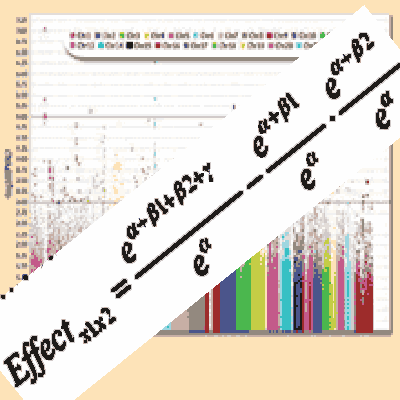 COM.on C.A.4:e10/57-60
Online published on Jun.22, 2010.
COM.on C.A.4:e10/57-60
Online published on Jun.22, 2010.doi:10.4236/coca.2010.41010
 COM.on C.A.4:e10/57-60
Online published on Jun.22, 2010.
COM.on C.A.4:e10/57-60
Online published on Jun.22, 2010.PENG Qianqian
MOE Laboratory of Contemporary Anthropology, School of Life Sciences, Fudan University, Shanghai 200433 China
Key words: genome-wide association study; interaction; characteristics of data; model hypothesis
Recieved: Jun.7, 2010 Accepted: Jun.11, 2010 Corresponding: qqpeng2009@gmail.com
《现代人类学通讯》第四卷e10篇 第57-60页 2010年6月22日网上发行
专题综述
对全基因组关联分析中一些问题的思考
彭倩倩
复旦大学生命科学学院现代人类学教育部重点实验室 上海200433
摘要:
关键词:
全基因组关联分析;交互作用;数据特征;模型假设
参考文献 References
1.McCarthy MI,
Zeggini E (2009)
Genome-wide association
studies in type 2 diabetes. Curr Diab
Rep 9: 164-171.
2.Hirschhorn JN, Lettre G (2009)
Progress in genome-wide association
studies of human height. Horm Res 71
Suppl 2: 5-13.
3.Grant SF, Hakonarson H (2009)
Genome-wide association studies in type
1 diabetes. Curr Diab Rep 9: 157-163.
4.Franke B, Neale BM, Faraone SV (2009)
Genome-wide association studies in ADHD.
Hum Genet 126: 13-50.
5.Ozaki K, Tanaka T (2005)
Genome-wide
association study to identify SNPs
conferring risk of myocardial infarction
and their functional analyses. Cell Mol
Life Sci 62: 1804-1813.
6.Weale ME (2010)
Quality control for
genome-wide association studies. Methods
Mol Biol 628: 341-372.
7.Robinson R (2010)
Common disease,
multiple rare (and distant) variants. PLoS Biol 8: e1000293.
8.Need AC, Goldstein DB (2010)
Whole
genome association studies in complex
diseases: where do we stand? Dialogues Clin Neurosci 12: 37-46.
9.Dickson SP, Wang K, Krantz I,
Hakonarson H, Goldstein DB (2010)
Rare
variants create synthetic genome-wide
associations. PLoS Biol 8: e1000294.
10.Cho JH (2010)
Genome-wide association
studies: present status and future
directions. Gastroenterology 138:
1668-1672 e1661.
11.Hindorff LA, Sethupathy P, Junkins
HA, Ramos EM, Mehta JP, Collins FS,
Manolio TA (2009)
Potential etiologic
and functional implications of
genome-wide association loci for human
diseases and traits. Proc Natl Acad Sci
U S A 106: 9362-9367.
12.Garcia-Magarinos M, Lopez-de-Ullibarri
I, Cao R, Salas A (2009)
Evaluating the
ability of tree-based methods and
logistic regression for the detection of
SNP-SNP interaction. Ann Hum Genet 73:
360-369.
13.Moore JH, Gilbert JC, Tsai CT, Chiang
FT, Holden T, Barney N, White BC (2006)
A flexible computational framework for
detecting, characterizing, and
interpreting statistical patterns of epistasis in genetic studies of human
disease susceptibility. J Theor Biol
241: 252-261.
14.Brassat D, Motsinger AA, Caillier SJ,
Erlich HA, Walker K, Steiner LL, Cree
BA, Barcellos LF, Pericak-Vance MA,
Schmidt S, Gregory S, Hauser SL, Haines
JL, Oksenberg JR, Ritchie MD (2006)
Multifactor dimensionality reduction
reveals gene-gene interactions
associated with multiple sclerosis
susceptibility in African Americans.
Genes Immun 7: 310-315.
15.Cook NR, Zee RY, Ridker PM (2004)
Tree and spline based association
analysis of gene-gene interaction models
for ischemic stroke. Stat Med 23:
1439-1453.
16.Bastone L, Reilly M, Rader DJ,
Foulkes AS (2004)
MDR and PRP: a
comparison of methods for high-order
genotype-phenotype associations. Hum Hered 58: 82-92.
17.Hahn LW, Ritchie MD, Moore JH (2003)
Multifactor dimensionality reduction
software for detecting gene-gene and
gene-environment interactions.
Bioinformatics 19: 376-382.
18.Ritchie MD, Hahn LW, Roodi N, Bailey
LR, Dupont WD, Parl FF, Moore JH (2001)
Multifactor-dimensionality reduction
reveals high-order interactions among
estrogen-metabolism genes in sporadic
breast cancer. Am J Hum Genet 69:
138-147.
19.Nelson MR, Kardia SL, Ferrell RE,
Sing CF (2001)
A combinatorial
partitioning method to identify multilocus genotypic partitions that
predict quantitative trait variation.
Genome Res 11: 458-470.
20.Wu X, Jin L, Xiong M (2008)
Composite
measure of linkage disequilibrium for
testing interaction between unlinked
loci. Eur J Hum Genet 16: 644-651.
21.Kang G, Yue W, Zhang J, Cui Y, Zuo Y,
Zhang D (2008)
An entropy-based approach
for testing genetic epistasis underlying
complex diseases. J Theor Biol 250:
362-374.
22.Dong C, Chu X, Wang Y, Jin L, Shi T,
Huang W, Li Y (2008)
Exploration of
gene-gene interaction effects using
entropy-based methods. Eur J Hum Genet
16: 229-235.
23.Cui Y, Kang G, Sun K, Qian M, Romero
R, Fu W (2008)
Gene-centric genomewide
association study via entropy. Genetics
179: 637-650.
24.Zhao J, Jin L, Xiong M (2006)
Test
for interaction between two unlinked
loci. Am J Hum Genet 79: 831-845.
25.Peng Q, Zhao J, Xue F (2010)
A
gene-based method for detecting
gene-gene co-association in a
case-control association study. Eur J
Hum Genet 18: 582-587.
26.Peng Q, Zhao J, Xue F (2010)
PCA-based bootstrap confidence interval
tests for gene-disease association
involving multiple SNPs. BMC Genet 11:
6.
27.Jung J, Zhao Y (2010) Allelic based
gene-gene interaction in case-control
studies. Hum Hered 69: 14-27.
28.Cordell HJ (2009)
Detecting gene-gene
interactions that underlie human
diseases. Nat Rev Genet 10: 392-404.
29.Musani SK, Shriner D, Liu N, Feng R,
Coffey CS, Yi N, Tiwari HK, Allison DB
(2007)
Detection of gene x gene
interactions in genome-wide association
studies of human population data.
Hum Hered 63: 67-84.
30.贾崇奇(2005) 交互作用分析方法. 见: 赵仲堂(ed)
流行病学研究方法与应用. 北京: 科学出版社, 523-544.
31.Cordell HJ (2002)
Epistasis: what it
means, what it doesn't mean, and
statistical methods to detect it in
humans. Hum Mol Genet 11: 2463-2468.
32.Gronlund A, Bhalerao RP, Karlsson J
(2009)
Modular gene expression in
Poplar: a multilayer network approach.
New Phytol 181: 315-322.
33.Horvath S, Dong J (2008)
Geometric
interpretation of gene coexpression
network analysis. PLoS Comput Biol 4:
e1000117.
34.Peng G, Luo L, Siu H, Zhu Y, Hu P,
Hong S, Zhao J, Zhou X, Reveille JD, Jin
L, Amos CI, Xiong M (2010)
Gene and
pathway-based second-wave analysis of
genome-wide association studies. Eur J
Hum Genet 18: 111-117.
35.Luo L, Peng G, Zhu Y, Dong H, Amos
CI, Xiong M (2010)
Genome-wide gene and
pathway analysis. Eur J Hum Genet, in
press.